After Indian Point
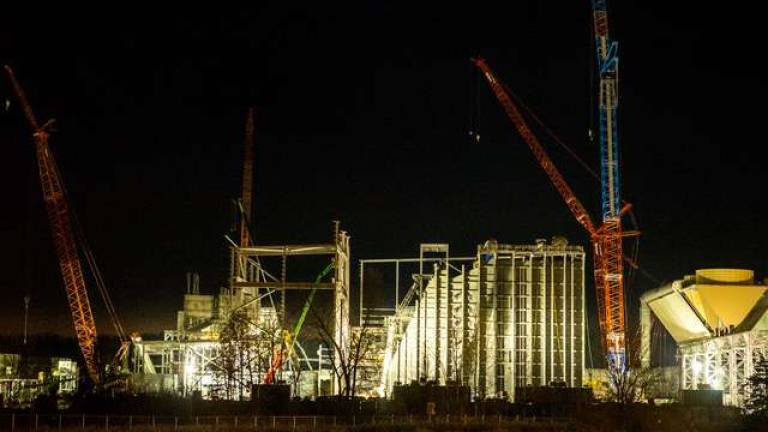
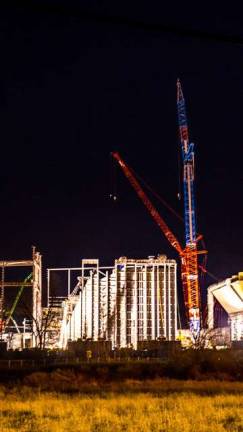
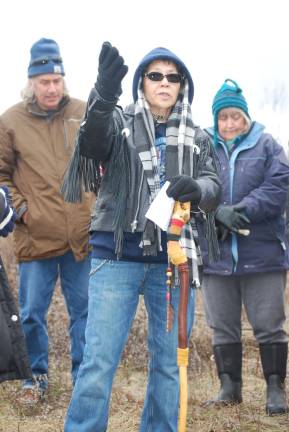
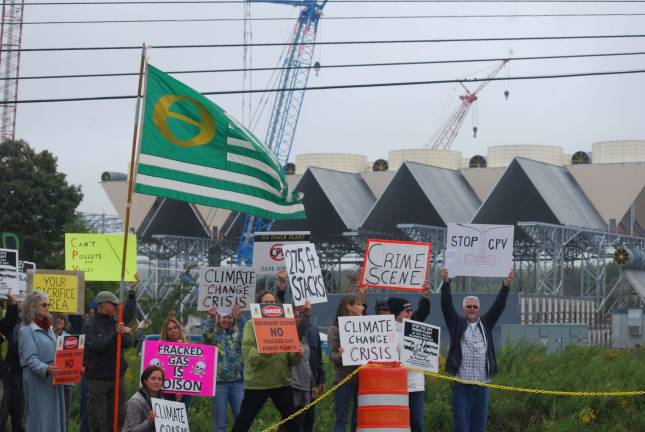
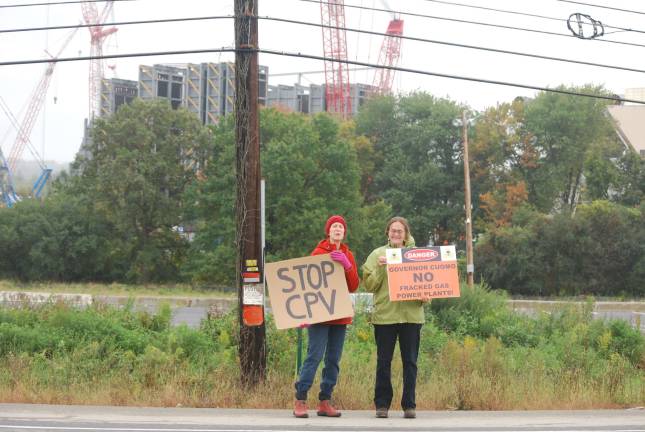
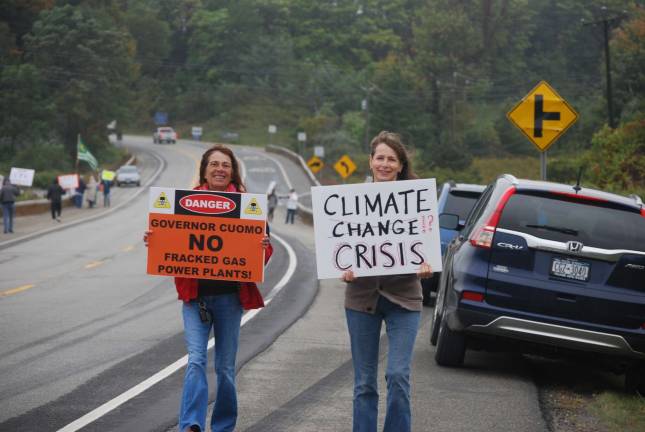
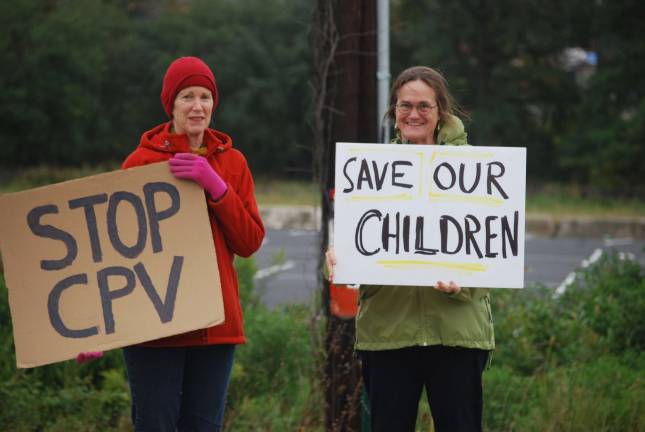
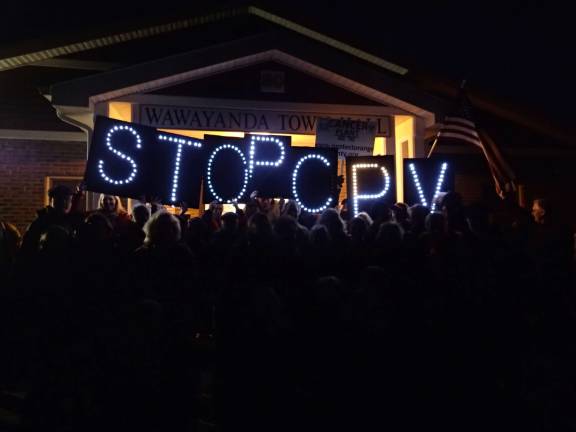
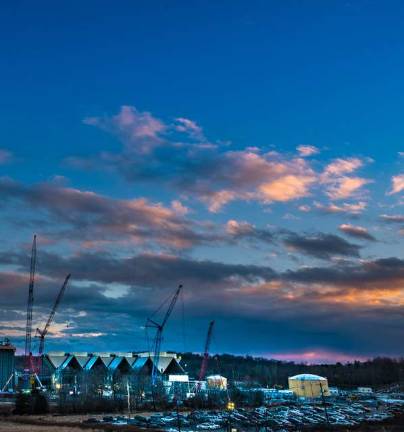
Will 2021 launch us into a renewable future? Or are we just trading poisons?
By Becca Tucker
Indian Point, the nuclear power plant that’s been powering our grid and periodically leaking into our river since the 60s, is on its way out. The “ticking time bomb,” as Governor Andrew Cuomo calls it, plans to shut down its final reactor in four years.
We can all begin to breathe a little easier. Right?
Not if you live across the Hudson River. As Indian Point prepares to power down in affluent Westchester County, NY, protesters are marching weekly at the site of a brand new power plant under construction 30 miles to the northwest, in working class Orange County, NY. The CPV Valley Energy Center, if it goes online, will burn fracked gas piped in from Pennsylvania, releasing emissions that pose many of the same health risks that fracking does.
“You can’t trade poisons and trade victims and call it an environmental victory,” said Pramilla Malick, a mother and neighbor of the power plant, whose arrest for blocking the CPV construction site launched her into politics. “We’re basically trading nuclear for gas, for people in Westchester for Orange County, which, by the way, is our foodshed.”
CPV’s spokesman, Steve Remillard, referred questions to the New York State Independent System Operator, the nonprofit that oversees our grid.
Cuomo’s office did not return calls by press time.
CPV’s twin smokestacks will tower over the silos of the black dirt region, whose famously fertile farms supply about 70 percent of the produce at New York City’s greenmarkets, according to Maire Ullrich of Cornell Cooperative Extension. Depending on which way the wind blows, its particulates will settle over a 30-mile radius that spans three states. Already, neighbors of the fracked gas compressor station built in 2013 in the rural town of Minisink, NY, a few miles from the rising CPV power plant, report that their children are suffering rashes, nosebleeds and headaches. Already, the air pollution in Minisink is worse than in a big city, according to a 2015 study by the Southwest Pennsylvania Environmental Health Project. CPV, which aims to go online in 2018, will release 43 times those emissions.
“It’s an unfair burden on families who are living in limbo because they understand that they cannot remain in this area if this plant becomes operational. Already families in Minisink have been forced to leave home. Governor Cuomo needs to make this community whole again,” she said. “This is absolutely categorically not fair to us. It’s also contradictory because this is allegedly a state that recognizes the health hazards of fracking. Then how on earth can you create a market for fracked and increase your dependency on fracked gas?”
The $900,000 plant has its cheerleaders. “We feel after eight years of vigorous review, our town is getting the best project possible,” said Wawayanda Town Supervisor John Razzano in an email. “Aside from the obvious esthetical issues associated with a plant of this size, we are pleased to say that they will not use any groundwater and will be using hundreds of thousands of gallons of recycled greywater from the City of Middletown sewer plant each day to cool the facility. This is a state of the art combined cycle gas turbine which will be one of, if not the most energy efficient in the country. This plant has many green components to it. Hopefully plants like this will provide a bridge to the future when wind, solar and other alternative energy sources can supply the state with the power we require without relying on fossil fuel.”
Orange County Executive Steve Neuhaus called CPV a “game-changer” that would “effectively position our region for attracting business and creating additional economic growth” in 2014. But that was before the scandal broke. Neuhaus has now joined the chorus clamoring for the state to hit the pause button.
In a corruption scheme that, if true, makes Bridgegate look like a cute prank, Cuomo’s former right hand man allegedly shook down a CPV higher-up in exchange for greasing the wheels as the power plant won state approvals, all right under the governor’s nose. One of the actions that Cuomo’s aide allegedly took to help CPV was to press for the closure of Indian Point. CPV’s chances of getting built depended “at least in part, on whether [Indian Point] was going to be shut down,” according to US Attorney Preet Bharara’s indictment.
Regardless of what did or didn’t happen in back rooms, Entergy, the utility that owns Indian Point, has been clear that it made up its own mind to shut down; no one ordered it to close. The 2,000-megawatt nuclear plant bowed only to the market, whose energy prices were driven way down by cheap fracked gas.
“Why have gas prices dropped?” said Bill Mohl, head of Entergy’s whole commodities division, at a press conference. “Obviously the shale gas phenomenon, and specifically for us the abundance of shale gas in the Marcellus Region. It’s driven power prices down across the entire region.” Indian Point is the tenth nuclear unit in the country that’s calling it quits, he said.
Natural gas just dethroned coal as king nationwide, and New York in particular is awash in fracked gas, according to numbers from the New York Independent Service Operator. Gas from Pennyslvania’s shale formations is probably heating your house right this minute. Chances are it’s powering my laptop as I type. New York banned fracking because it’s destructive, but we love fracked gas because it’s cheap. It’s so cheap at the moment that it makes it hard for anyone else – coal, nuclear, or renewables – to compete.
So now here we are, in the most Kafkaesque of moments. While Cuomo’s top aide stands trial for conspiracy to commit extortion, the power plant that allegedly bribed him is going up, and the nuclear plant he was allegedly paid to oppose is shutting down. Cuomo responded to the charges against the man he has called his father’s third son by saying he was “saddened and profoundly disappointed,” and he severed communication with CPV. But actions speak louder than words. The protesters are adamant that nothing short of rejecting the plant will make things right.
“We in Orange County cannot ever forget that this was a policy that was at the heart of the corruption scandal,” said Malick. “The only way they can prove to Orange County that this is not a result of pay to play is by calling for the shutdown of CPV.”
It happens that the one piece of paper CPV still needs before it can go online is in Governor Cuomo’s hands, and – as he did with the fracking ban – he’s taking his sweet time making the call. The New York State Department of Environmental Conservation has to issue or deny a water quality permit for a 7.8-mile pipeline extension that would bring gas from the Millennium Pipeline to the power plant. The state has dragged its feet so long that the pipeline company is suing the state for what is claims is an unlawful delay. The state says it has until August 2017.
The permit may sound like a bureaucratic “t” to be crossed, but without it, the shiny 650-megatt power plant will never make a watt of power. Last spring, Cuomo handed environmentalists a major eleventh-hour victory when he denied this same permit to the Constitution Pipeline, nixing an artery that would have brought fracked gas 125 miles from Pennsylvania, through the Catskills to New York City and New England.
The sheer enormity of the rising power plant makes it hard to believe that anything could stand in its way now. “People have tried to band together, but the dollars behind the project, it’s insurmountable for people to put the brakes on something like this, it seems to me,” said Ray Sosler, whose property backs up to the construction site. Where once were wetlands with “weed grass and little frogs and turtles going around, now it looks like something in the Man of Steel movie that came down from Krypton and crashed in our backyard, you know?”
Since it broke ground, the construction has not stopped, said Sosler, who owns a farm supply company and has two young children. He called the town once to complain about construction noise at night, but was told there were no limitations on an industrial site. “They can run equipment 24 hours a day, can have lights that make it look like daytime in the middle of the night,” he said.
But just because they built the thing in a hurry, “that doesn’t give them any more right to the permit than on the first day,” said Michael Sussman, a lawyer who is suing CPV for not following proper environmental protocol. “If they went and spent millions of dollars that’s at their peril,” he said.
Former Ohio congressman and presidential candidate Dennis Kucinich has called the plant “fruit from the poisoned tree” and pressed Governor Cuomo to salvage his integrity and scrap it. Actress Susan Sarandon says CPV’s greenhouse gas emissions will “ensure that Lower Manhattan is eventually going to be swallowed up by the ocean.” Actor James Cromwell was one of the six people arrested for chaining themselves to the CPV construction site. State Senator Tony Avella, who penned the bill to ban fracking, wrote a letter to the New York State Public Service Commission saying the plant would “derail public policy initiatives to transition to renewable energy resources” – and that was before the scandal.
It’s a perplexing situation we’re in here in Orange County. Why is this thing still going up when its permits may well have been illegally obtained? How is it that despite all the outcry, construction hasn’t paused pending the outcome of the investigation? Why we are hearing about a renewable New York while we see this throwback rise in our backyard?
“Look, we’re at a crisis point,” said Alex Beauchamp, northeast regional director of the nonprofit Food & Water Watch. “Here in New York we need to be pursuing a huge buildout of renewable energy and a complete rejection of fossil fuels across the state.”
“The infrastructure we build over next five years will contribute a lot to whether we are able to meet our long term climate goals,” said Dr. Sacha Spector, program director for the environment at the Doris Duke Charitable Foundation. He pointed out that gas plants, unlike coal, nuclear or renewables, have the unique capability to turn on and off as needed, which “can play into a transition to renewables, particularly while we don’t have great storage yet.”
“But I don’t want to come off as an apologist for these gas plants,” he said. “If we continue to build out large infrastructure that’s dependent on fossil fuels, and turn those investors into advocates of sustained use of fossil fuel, that is exactly what we’ll end up with.”
CPV is one of about 300 proposed fracked gas power plants nationwide, an average of six per state. In our neck of the woods, we’re certainly seeing that trend come to pass: in addition to CPV in Orange County, the 1,100-megawatt Cricket Valley Energy Center just got green lighted to fire up in 2020 in Dutchess County, about 50 miles northeast of Indian Point.
But an alternate future is possible – if people make enough noise. Since the fracking ban, New York has begun to emerge as a national leader in sustainability, right up there with Hawaii and California. “Making sure that every single state legislator knows that renewables is a priority for their voters is critical,” said Spector. “And that it’s important to us as New Yorkers that we win that competition to be the first fossil fuel-free state. Hawaii is going to beat us,” he added. “But a little competition across states would be great.” Fun fact: New Yorkers are the most efficient power users in the country on a per capita basis.
It’s actually a really exciting time to be a New Yorker. Governor Cuomo’s Clean Energy Plan calling for 50 percent renewable energy by 2030 – although critics say it’s not bold enough – is one of the most aggressive plans in the country.
Replacing Indian Point with renewables is entirely doable, according to Cliff Weathers, spokesman for Riverkeeper. Riverkeeper, an environmental watchdog group, worked closely with Entergy and the state on the Indian Point shutdown agreement. If we were to shut down Indian Point today, we would have to rely on oil and natural gas as a crutch, said Weathers. But four years from now, fossil fuels “probably won’t be needed at all,” except maybe as backup for times of peak usage, he said.
Thanks to enormous upgrades in grid efficiency and ambitious renewable projects, like 1,000 megawatts of Canadian hydropower “coming straight into the city,” a solar sector that’s exploding “beyond what was ever dreamed,” and the country’s largest wind farm off the coast of Long Island, New York State will have plenty of power after Indian Point shuts down, said Weathers. We will not need CPV to make up for the loss, he said more than once. “CPV is not part of the energy mix that Riverkeeper foresaw when trying to close Indian Point – period.” Riverkeeper has written two letters, one to the Town of Wawayanda Planning Board in 2013 and one to the Federal Energy Regulatory Commission in 2016, urging them not to approve CPV or its infrastructure.
Going renewable is going to be a Herculean undertaking, far bigger than anything we’re thinking about right now, says Keith Schue, an electrical engineer and policy wonk who lives upstate. Cuomo’s Clean Energy Plan is “a step forward,” said Schue, but given the distance between today’s reality and a renewable future, shutting down carbon-free nuclear power prematurely is akin to “shooting ourselves in the foot – or in the face, actually.”
While renewables are gaining traction in New York, the scale of the projects on the table doesn’t even put us in the right ballpark, said Schue. We’re just focused on electricity, for starters, while transportation and heat make up three-quarters of our energy pie. “We need to see a huge, rapid deployment of those renewables very, very quickly,” said Schue.
“It’s definitely the case we need to ramp them up much faster than we are now. The longer we wait, the more painful the transition will be,” said Beauchamp. “But the short answer is yes, it can be done and needs to be. The problem is not technical. It depends on whether we have the political will to do it.”
In the meantime, Sosler and his wife watch “this thing popping up right out of the ground, like something from Krypton,” and console themselves the best they can. For the rest of their lives, when they get a pizza delivered, they can just say, “You know where the power plant is? We’re right behind it.”